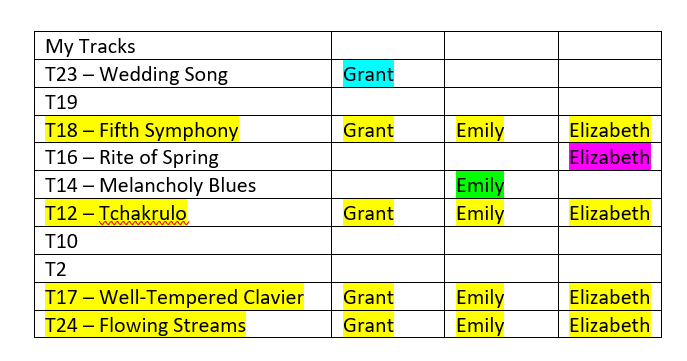For this assignment, I preferred using the tables generated by Palladio file. First I found the community I had been sorted into on the Palladio file. Grant, Emily, Elizabeth and I shared four common tracks, which have been highlighted in yellow.

I made this table to help me better visualize and make sense of our choices. Both the least and most selected tracks were picked by everyone within my community: The Well-Tempered Clavier and Flowing Streams.
Due to the popularity of Flowing Streams, I wondered if diversity and representation were common themes among everyone’s lists. I read the Task 8 assignments from the people in my community and some random ones from neighbouring communities, and it seems that many people strived for representation of diverse cultures and identities.
During Task 8, I tried to choose tracks with a diversity of cultures and identities in mind, but I was concerned about how I went about this because
- Diverse representation could imply to extra-terrestrials that diversity is widely valued and exists peacefully.
- Actually we live in a world where biases are perpetuated in algorithms which allows individuals to live with little exposure to different perspectives (Edwards, 2019).
- Choosing tracks from different cultures felt like tokenism since it does not address the underlying issues that exist.
- Representation by population ignores the minority groups that do not have the population numbers or cultural clout to be represented.
- The data input into algorithms are used to identify current and future trends. How can we be sure that the algorithm will interpret this data so it values diversity?
- The impossibility of representing all cultures through 10 tracks makes me wonder if a better way to represent all humans is being overlooked by the majority, thus ignored by the algorithms. The most advanced algorithms use neural networks that are designed copy the way the human mind works and identify underlying relationships within a data set (Edwards, 2019), which means diversity of thought will be limited by the data set.
I looked at Task 8 completed by people in the community farthest from mine. One thing I noticed was the people in this group all mentioned auditory aesthetics, which I feel, were not so prominent in the Task 8 assignments from people in my community. Next I visited the Task 8 assignment of two people who had not chosen Flowing Streams, Johanna and Danya. Johanna listened to the tracks and used universal human experiences, feelings, to curate her tracks. Danya’s process involved using research and sound to pick tracks that represent the world through history, geographical representation, variety of musical instruments, rhythms and melodies to narrow down her initial choices. Like Johanna, she selected her final ten through listening. A completely different approach than mine, but nevertheless effective. Because this data was not in my immediate community, I doubt I would have seen this in any of my searches or social media feeds. If I were to complete Task 8 again, I would seriously consider approaching the task from human emotions because feelings are something everyone experiences and can relate to. Perhaps it would be easier to achieve diversity through universal feelings?
References
Edwards, J. (2019, August 19). What is predictive analytics? Transforming data into future insights. CIO. https://www.cio.com/article/3273114/what-is-predictive-analytics-transforming-data-into-future-insights.html

Hi Sheena,
I enjoyed reading your take on this. The question you asked at the end of this post had me really thinking. Feelings or emotions are universal but I think they can be perceived or experienced differently depending on our cultures. Good question and thanks for sharing!
Hi Grant,
Thanks for your comment because it made me think about how feelings can create connections despite our differences. I agree that our perception of feelings and emotions are coloured by our cultures and experiences. I think feelings can help us better understand our differences. For example, in some cultures, it is acceptable for women to speak about their menstrual cycles in public, but in other cultures, it makes people uncomfortable. The topic is experienced differently, but most people can relate to the feeling of discomfort which can make it easier to relate to each other. At the same time, people may feel marginalized that they cannot speak about an important everyday part of a biological woman’s life. Understanding this feeling may make it easier for people to get over their discomfort so they can listen.